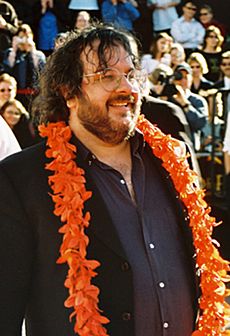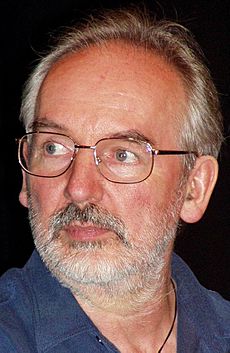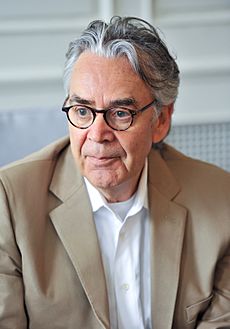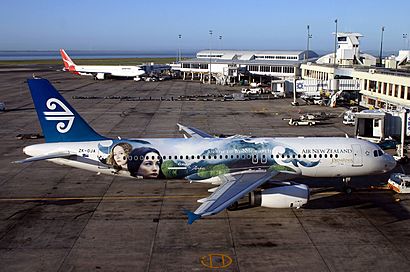The Lord of the Rings (film series) facts for kids
Quick facts for kids The Lord of the Rings |
|
|---|---|
 |
|
| Directed by | Peter Jackson |
| Produced by |
|
| Screenplay by |
|
| Starring | |
| Music by | Howard Shore |
| Cinematography | Andrew Lesnie |
| Editing by |
|
| Distributed by | New Line Cinema |
| Release date(s) | 2001–2003 |
| Running time | Total (3 films):
|
| Country |
|
| Language | English |
| Budget | Total (3 films): $287 million |
| Money made | Total (3 films): $2.993 billion |
The Lord of the Rings is a series of three amazing fantasy adventure films. They were directed by Peter Jackson. These movies are based on the famous book The Lord of the Rings by J. R. R. Tolkien.
The three films are:
- The Fellowship of the Ring (released in 2001)
- The Two Towers (released in 2002)
- The Return of the King (released in 2003)
New Line Cinema and WingNut Films worked together to make these movies. Many talented actors starred in them, including Elijah Wood, Ian McKellen, Liv Tyler, and Orlando Bloom.
The story takes place in a magical world called Middle-earth. It follows a brave hobbit named Frodo Baggins. He goes on a very important journey to destroy a powerful item called the One Ring. This ring was made by the evil Dark Lord Sauron.
Frodo is not alone. He starts with a group called the Fellowship. Later, he continues his quest with his loyal friend Sam and a tricky creature named Gollum. Meanwhile, other heroes like Aragorn, the elf Legolas, the dwarf Gimli, and the wizard Gandalf fight to save Middle-earth from Sauron's army. They hope to help Frodo by keeping Sauron busy.
All three films were filmed at the same time in New Zealand. This was a huge and ambitious project! It cost about $281 million. The movies were a massive success, earning almost $3 billion worldwide. Critics and audiences loved them for their acting, directing, special effects, and how true they stayed to the books. The series won many awards, including 17 Academy Awards. The Return of the King even won Best Picture!
Contents
The Amazing Story
The Fellowship of the Ring
This first film introduces us to the Shire, where hobbits live. Frodo inherits a magical ring from his uncle, Bilbo. He soon learns it's the One Ring, a dangerous tool of the Dark Lord Sauron. Frodo must take the Ring to Mordor to destroy it. He sets off with his friends and forms the Fellowship. This group includes hobbits, an elf, a dwarf, a human, and a wizard. They face many dangers on their journey.
The Two Towers
The Fellowship splits up in the second film. Frodo and Sam continue their difficult journey to Mordor. They meet Gollum, who used to own the Ring. Meanwhile, Aragorn, Legolas, and Gimli help the people of Rohan fight against Saruman's evil army. Merry and Pippin, the other hobbits, escape and meet Treebeard, a giant tree-like creature.
The Return of the King
In the final film, the heroes unite to fight Sauron's forces in a huge war. They try to distract Sauron so Frodo can complete his mission. Frodo and Sam finally reach Mount Doom in Mordor. This is the only place where the One Ring can be destroyed. The fate of Middle-earth depends on them.
Meet the Cast and Crew
Choosing the Actors
Director Peter Jackson and his team worked hard to find the perfect actors. They had a "wishlist" of actors they wanted. For example, they really wanted Ian McKellen to play Gandalf. Christopher Lee wanted to play Gandalf too, but Peter Jackson thought he would be an even better Saruman.
Finding the right actor for Aragorn was a bit tricky. They first cast Stuart Townsend, but later decided he was too young. So, they found Viggo Mortensen, who became a fan favorite! Many famous actors were considered for different roles, showing how big this project was.
Main Cast Members
Here are some of the main actors and the characters they played:
| Character | The Fellowship of the Ring | The Two Towers | The Return of the King |
|---|---|---|---|
| The Fellowship | |||
| Frodo Baggins | Elijah Wood | ||
| Aragorn | Viggo Mortensen | ||
| Boromir | Sean Bean | ||
| Meriadoc "Merry" Brandybuck | Dominic Monaghan | ||
| Samwise Gamgee | Sean Astin | ||
| Gandalf | Ian McKellen | ||
| Gimli | John Rhys-Davies | ||
| Legolas | Orlando Bloom | ||
| Peregrin "Pippin" Took | Billy Boyd | ||
| Other Key Characters | |||
| Bilbo Baggins | Ian Holm | Ian Holm | |
| Arwen | Liv Tyler | ||
| Elrond | Hugo Weaving | ||
| Galadriel | Cate Blanchett | ||
| Gollum / Sméagol | Andy Serkis | ||
| Gríma Wormtongue | Brad Dourif | ||
| Saruman | Christopher Lee | ||
| Sauron | Sala Baker
Alan Howard (voice) |
Sala Baker
Alan Howard (voice) |
|
| Denethor | John Noble | ||
| Éomer | Karl Urban | ||
| Éowyn | Miranda Otto | ||
| Faramir | David Wenham | ||
| Théoden | Bernard Hill | ||
| Treebeard | John Rhys-Davies (voice) | ||
The Production Team
A huge team worked behind the scenes to bring Middle-earth to life. Here are some of the key crew members:
| Crew Role | |||
|---|---|---|---|
| The Fellowship of the Ring | The Two Towers | The Return of the King | |
| Director | Peter Jackson | ||
| Producers | Barrie M. Osborne, Peter Jackson, Fran Walsh, and Tim Sanders | ||
| Screenwriters | Fran Walsh, Philippa Boyens, Peter Jackson, and Stephen Sinclair | ||
| Composer | Howard Shore | ||
| Cinematographer | Andrew Lesnie | ||
| Editors | John Gilbert | Michael Horton | Jamie Selkirk |
| Production designers | Dan Hennah and Grant Major | ||
| Conceptual designers | Alan Lee and John Howe | ||
| Costume designers | Ngila Dickson and Richard Taylor | ||
| Visual effects supervisor | Jim Rygiel | ||
| Production companies | New Line Cinema and WingNut Films | ||
| Distributing company | New Line Cinema | ||
- FOTR indicates he only worked on The Fellowship of the Ring.
- TT indicates he only worked on The Two Towers.
- ROTK indicates he is only credited as editor on The Return of the King.
How the Films Were Made

Early Ideas for the Films
Before Peter Jackson, other filmmakers tried to adapt Tolkien's books. Some made animated movies, like the 1978 film The Lord of the Rings. Peter Jackson saw this animated movie when he was a teenager. He liked parts of it, but it also made him want to read the book to understand the full story.
Bringing the Vision to Life
In 1995, Peter Jackson and his writing partner, Fran Walsh, decided to try making a fantasy film. They realized that The Lord of the Rings was the perfect story. They first talked to Miramax, a film studio. Jackson wanted to make three films, but Miramax only wanted two.
As they wrote the scripts, it became clear that the movies would be very expensive. Miramax wanted to cut the project down to just one film. Peter Jackson refused because he knew it wouldn't do the story justice.
Then, a different studio, New Line Cinema, stepped in. Their CEO, Robert Shaye, loved the idea! He even asked Jackson to expand it into a full trilogy. This was great news for the project. New Line Cinema gave the team the freedom and budget they needed.
Filming and Special Effects

Peter Jackson and his team started designing Middle-earth in 1997. They didn't just copy the books exactly. They changed some parts of the story to make it clearer for movie viewers. They also added or moved some scenes.
Two famous Tolkien artists, Alan Lee and John Howe, joined the project. Their artwork greatly influenced how Middle-earth looked in the films. Jackson wanted the movies to feel real, like historical epics, not just fantasy. He wanted them to look like Braveheart but with a touch of magic.
Filming for all three movies happened at the same time in New Zealand. They shot scenes in over 150 different locations! This included beautiful national parks and soundstages. Filming lasted from October 1999 to December 2000. They also did extra filming each year until 2004.
The special effects team, Weta Digital, created amazing new technology. They developed software called MASSIVE. This software could create huge crowds of intelligent characters for battle scenes. They also improved motion capture technology. This allowed actors like Andy Serkis (who played Gollum) to bring their characters to life in a new way.
Each film had a full year of post-production. This is where they edited the film, added music, and finished the special effects. The editors had to work through a massive amount of footage. In the end, they cut down 1,828 kilometers of film to create the 11-hour extended version of the trilogy!
The Music of Middle-earth

Howard Shore wrote all the music for The Lord of the Rings. He visited the film sets and started composing even before filming began. Shore created many different musical themes, called leitmotifs. These themes represented different characters, places, and cultures in Middle-earth. For example, there are special themes just for the hobbits and the Shire.
Most of the music was recorded by the London Philharmonic Orchestra. Many talented singers and musicians also contributed. Even some of the actors, like Billy Boyd and Viggo Mortensen, sang or played a small part in the music! The songs were written in Tolkien's languages. The final song, "Into the West", was a special tribute.
The music for The Lord of the Rings is incredibly popular. It has often been voted the best movie soundtrack of all time!
Official Soundtracks
| Title | U.S. release date | Length | Composer | Label |
|---|---|---|---|---|
| The Fellowship of the Ring: Original Motion Picture Soundtrack | 20 November 2001 | 71:29 | Howard Shore | Reprise Records |
| The Two Towers: Original Motion Picture Soundtrack | 10 December 2002 | 72:46 | ||
| The Return of the King: Original Motion Picture Soundtrack | 25 November 2003 | 72:05 |
The Legacy of the Films
The Lord of the Rings films made Tolkien's books even more popular. They led to many video games and other merchandise.
The Hobbit Trilogy
From 2012 to 2014, Peter Jackson also directed The Hobbit film trilogy. These movies tell the story that happens before The Lord of the Rings. They include The Hobbit: An Unexpected Journey, The Hobbit: The Desolation of Smaug, and The Hobbit: The Battle of the Five Armies.
The War of the Rohirrim
A new animated movie, The War of the Rohirrim, is set to be released in 2024. It's a prequel to Peter Jackson's films. It tells a story from Middle-earth's past.
Cast Reunions
In 2020, during the COVID-19 pandemic, many of the original cast members had a virtual reunion online. They talked about their time making the films. Director Peter Jackson and composer Howard Shore also joined. This reunion helped raise money for charity.
Impact on Film and Tourism
The success of The Lord of the Rings made Peter Jackson a very important director. The films also made fantasy movies popular again. Many people now visit New Zealand because they want to see the beautiful places where the movies were filmed.
In 2002, a special exhibition about the film trilogy traveled around the world. It showed props, costumes, and designs from the movies.
Video Games
Many video games have been made based on the film series. These include:
- The Two Towers
- The Return of the King
- Lego The Lord of the Rings
- Middle-earth: Shadow of Mordor
- Middle-earth: Shadow of War
See also
 In Spanish: Trilogía cinematográfica de El Señor de los Anillos para niños
In Spanish: Trilogía cinematográfica de El Señor de los Anillos para niños


















